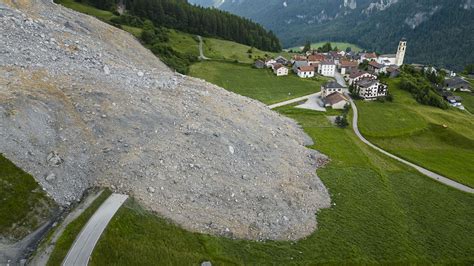
A section of the Trift glacier collapsed in the Swiss Alps on Saturday, unleashing a torrent of mud and rock that buried buildings in the village of Schwanden, Canton Glarus, forcing evacuations and causing significant damage. While no injuries or fatalities have been reported, the event highlights the increasing risks posed by glacial melt due to climate change.
The debris flow, triggered by the glacier’s instability and recent heavy rainfall, swept through the village, engulfing homes, businesses, and infrastructure in a thick layer of mud and rock. Authorities had been monitoring the glacier for weeks, issuing warnings about potential landslides, and the evacuation order, issued just hours before the collapse, likely prevented casualties.
“A considerable amount of material came loose,” the local police department said in a statement, describing the event as a “major natural event.” The extent of the damage is still being assessed, but initial reports suggest several buildings have been severely impacted, and the village is currently inaccessible.
The Catastrophic Collapse
The collapse occurred on Saturday morning, sending a wave of mud, rock, and ice crashing down the mountainside and into Schwanden. Witnesses described a deafening roar as the debris flow descended, followed by a scene of devastation.
“We were expecting something, but not on this scale,” said a resident who was evacuated from their home. “The whole village is covered in mud. It’s unbelievable.”
The affected area is estimated to be several hectares in size, with buildings buried under several meters of debris. The force of the flow was so powerful that it uprooted trees, destroyed roads, and even moved some buildings off their foundations.
Emergency services, including firefighters, police, and mountain rescue teams, were immediately deployed to the scene. Their primary focus was on ensuring the safety of residents and assessing the damage. Helicopters were used to survey the area and transport personnel and equipment.
Preemptive Evacuations Save Lives
The evacuation order, issued by the local authorities based on data from monitoring systems and expert assessments, proved to be crucial in preventing loss of life. Residents were given only a few hours to gather essential belongings and leave their homes.
“The decision to evacuate was not taken lightly,” said a spokesperson for the Canton Glarus government. “But the safety of our residents is our top priority. We are grateful that everyone heeded the warnings and evacuated in time.”
The effectiveness of the evacuation highlights the importance of early warning systems and proactive disaster management. The authorities had been monitoring the glacier’s movements and had identified areas at risk of landslides. This allowed them to make informed decisions and take timely action.
Climate Change and Glacial Instability
The collapse of the Trift glacier is the latest in a series of incidents that have raised concerns about the impact of climate change on the Alpine region. Glaciers are melting at an accelerating rate due to rising temperatures, making them increasingly unstable and prone to collapse.
“Glaciers are natural indicators of climate change,” said Professor Andreas Vieli, a glaciologist at the University of Zurich. “Their retreat is a clear sign that the climate is warming. As glaciers melt, they become less stable and more likely to trigger landslides and debris flows.”
The melting of glaciers also contributes to rising sea levels and can disrupt water supplies for communities that rely on glacial meltwater. The long-term consequences of glacial melt are far-reaching and pose a significant threat to both the environment and human societies.
The Aftermath and Recovery Efforts
The immediate focus is on clearing the debris and making the village safe for residents to return. However, the recovery process is expected to be lengthy and challenging.
“It will take time to rebuild and restore the village,” said a local official. “We are committed to providing support to the affected residents and working together to create a sustainable future for Schwanden.”
The authorities have established a relief fund to help residents cover the costs of temporary housing, food, and other essential needs. They are also working with insurance companies to assess the damage and provide compensation to those who have lost their homes or businesses.
Experts are conducting further assessments of the glacier and the surrounding area to determine the risk of future collapses. They are also exploring options for stabilizing the glacier and preventing further landslides.
The event in Schwanden serves as a stark reminder of the vulnerability of mountain communities to the impacts of climate change. It also underscores the importance of investing in early warning systems, disaster preparedness, and climate mitigation measures.
Long-Term Implications and Mitigation Strategies
The Schwanden disaster raises crucial questions about the future of settlements in mountainous regions facing similar threats. As climate change continues to accelerate glacial melt, other villages and towns nestled near glaciers are increasingly vulnerable. This necessitates a comprehensive approach encompassing risk assessment, preventative measures, and adaptation strategies.
One key aspect is improving monitoring systems. Advanced technologies like satellite imagery, ground-based radar, and GPS sensors can provide real-time data on glacier movement and stability, enabling authorities to detect potential hazards early. These systems need to be coupled with robust data analysis and predictive modeling to forecast the likelihood and potential impact of glacial collapses.
Furthermore, land-use planning needs to be carefully considered. Building codes should be updated to reflect the increased risk of natural disasters, and construction in high-risk zones should be restricted or subject to stringent safety requirements. Relocation programs may be necessary in some cases, although these are often complex and sensitive issues that require careful consultation with affected communities.
Engineered solutions can also play a role in mitigating the risks. These include constructing debris flow barriers, reinforcing slopes, and installing drainage systems to reduce water pressure within glaciers. However, such measures are often expensive and may have limited effectiveness in the face of large-scale glacial collapses.
Ultimately, addressing the root cause of the problem – climate change – is essential for ensuring the long-term safety of mountain communities. This requires a global effort to reduce greenhouse gas emissions and transition to a more sustainable economy. At the local level, communities can adopt measures to reduce their carbon footprint and promote climate resilience.
Community Resilience and Adaptation
The strength and resilience of the Schwanden community will be crucial in the recovery process. The disaster has undoubtedly caused immense trauma and hardship, but it has also brought people together in a spirit of solidarity and mutual support.
Community-based disaster preparedness programs can empower residents to take action to protect themselves and their property. These programs can include training in first aid, evacuation procedures, and emergency communication. They can also help to build social networks and strengthen community bonds.
In addition to physical infrastructure, social infrastructure is also essential for building resilience. This includes providing access to mental health services, supporting community organizations, and promoting social inclusion.
The Schwanden disaster is a wake-up call for communities around the world that are facing the impacts of climate change. It highlights the need for proactive planning, effective risk management, and strong community resilience. By working together, we can create a more sustainable and safer future for all.
International Cooperation and Knowledge Sharing
The challenges posed by glacial melt and related hazards are not unique to Switzerland. Many other countries around the world, particularly in the Himalayas, Andes, and other mountainous regions, are facing similar threats.
International cooperation and knowledge sharing are essential for addressing these challenges effectively. Countries can learn from each other’s experiences and share best practices in risk assessment, disaster preparedness, and climate adaptation.
International organizations such as the United Nations, the World Bank, and the International Panel on Climate Change (IPCC) can play a vital role in facilitating this cooperation. They can provide funding, technical assistance, and platforms for knowledge exchange.
Research and development are also crucial. Further research is needed to improve our understanding of glacial dynamics, predict the likelihood of glacial collapses, and develop effective mitigation strategies.
By working together, the international community can help to protect vulnerable communities from the devastating impacts of climate change.
The Human Cost and Emotional Toll
While the absence of fatalities is a relief, the Schwanden disaster has taken a significant emotional toll on the residents. The sudden loss of homes, businesses, and a sense of security can have profound psychological effects.
Many residents are experiencing anxiety, stress, and grief. They may also be struggling to cope with the uncertainty of the future.
Providing mental health support is essential for helping residents to recover from the trauma of the disaster. This includes offering counseling services, support groups, and other forms of psychological assistance.
It is also important to acknowledge the emotional toll on first responders and emergency personnel. They are often exposed to traumatic events and may need support to cope with the stress and pressure of their work.
The recovery process is not just about rebuilding physical infrastructure; it is also about healing emotional wounds and restoring a sense of community.
Looking Ahead: Building a More Resilient Future
The Schwanden disaster is a stark reminder of the challenges that lie ahead as climate change continues to reshape our world. It is a call to action for individuals, communities, and governments to take urgent steps to reduce greenhouse gas emissions, adapt to the impacts of climate change, and build a more resilient future.
This requires a fundamental shift in our thinking and our actions. We need to move beyond a reactive approach to disaster management and embrace a proactive approach that prioritizes prevention and preparedness.
We need to invest in early warning systems, strengthen infrastructure, and promote community resilience. We also need to address the root causes of climate change and transition to a more sustainable economy.
The Schwanden disaster is a tragedy, but it can also be an opportunity. It can be an opportunity to learn from our mistakes, to strengthen our communities, and to build a more resilient future for all.
The Role of Insurance
Insurance plays a crucial role in helping communities recover from natural disasters like the Schwanden glacier collapse. Homeowners’ insurance policies typically cover damage from events such as landslides and debris flows, but the extent of coverage can vary depending on the policy and the specific circumstances.
In Switzerland, natural disaster insurance is often mandatory, providing a safety net for homeowners who are affected by events like the Schwanden collapse. However, even with insurance, homeowners may still face challenges in navigating the claims process and receiving adequate compensation.
It is important for homeowners to carefully review their insurance policies and understand the extent of their coverage. They should also be prepared to document the damage to their property and work with insurance adjusters to file a claim.
Insurance companies also have a role to play in promoting disaster resilience. They can offer incentives for homeowners to invest in mitigation measures, such as installing debris flow barriers or reinforcing slopes. They can also work with communities to develop disaster preparedness plans.
FAQ Section
Q1: What caused the glacier collapse in Schwanden, Switzerland?
A: The glacier collapse was triggered by a combination of factors, primarily the melting of the Trift glacier due to rising temperatures caused by climate change, coupled with recent heavy rainfall. The melting ice destabilized the glacier, and the excess water lubricated the ground, leading to a massive debris flow of mud and rock.
Q2: Were there any casualties or injuries reported as a result of the collapse?
A: Fortunately, no injuries or fatalities were reported. This is largely attributed to the timely evacuation order issued by local authorities, who had been monitoring the glacier’s activity and identified a potential risk of landslides. Residents were given a few hours to evacuate before the collapse occurred.
Q3: What is the extent of the damage in Schwanden, and what is being done to help the affected residents?
A: The village of Schwanden sustained significant damage, with several buildings buried under mud and rock. Roads were destroyed, and infrastructure was severely impacted. Emergency services are focused on clearing debris and making the area safe. A relief fund has been established to provide temporary housing, food, and other essential needs to the affected residents. Authorities are also working with insurance companies to assess the damage and provide compensation.
Q4: What are the long-term implications of this event, and what measures can be taken to prevent similar disasters in the future?
A: The Schwanden collapse highlights the increasing risk of glacial-related disasters due to climate change. Long-term implications include the potential displacement of communities, economic losses, and environmental damage. Preventative measures include investing in advanced monitoring systems for glaciers, implementing stricter land-use planning regulations, constructing debris flow barriers, and, most importantly, addressing the root cause of climate change by reducing greenhouse gas emissions. International cooperation and knowledge sharing are also crucial for helping communities adapt to these challenges.
Q5: How is climate change contributing to glacier collapses, and what can be done to mitigate these effects?
A: Climate change is causing glaciers to melt at an accelerated rate, destabilizing them and increasing the risk of landslides and debris flows. As temperatures rise, glaciers lose mass and become less structurally sound. To mitigate these effects, it is essential to reduce greenhouse gas emissions by transitioning to renewable energy sources, improving energy efficiency, and adopting sustainable land-use practices. Adaptation measures, such as early warning systems and infrastructure improvements, are also necessary to protect vulnerable communities.
Further Considerations and Detailed Analysis:
The Schwanden incident is not an isolated event. It is part of a growing trend of glacier-related disasters occurring worldwide as climate change accelerates. According to the IPCC, glaciers have been losing mass at an unprecedented rate in recent decades, and this trend is projected to continue in the future.
The implications of glacial melt are far-reaching. In addition to the risk of landslides and debris flows, glacial melt also contributes to rising sea levels, threatens water supplies for communities that rely on glacial meltwater, and alters ecosystems.
Addressing the challenges posed by glacial melt requires a multi-faceted approach that includes mitigation, adaptation, and resilience-building.
Mitigation:
Mitigation efforts focus on reducing greenhouse gas emissions to slow down the rate of climate change. This requires a global effort to transition to a low-carbon economy. Key mitigation strategies include:
- Renewable Energy: Investing in renewable energy sources such as solar, wind, and hydropower to reduce reliance on fossil fuels.
- Energy Efficiency: Improving energy efficiency in buildings, transportation, and industry to reduce energy consumption.
- Sustainable Transportation: Promoting sustainable transportation options such as public transit, cycling, and walking.
- Carbon Capture and Storage: Developing technologies to capture carbon dioxide emissions from power plants and other industrial sources and store them underground.
- Afforestation and Reforestation: Planting trees to absorb carbon dioxide from the atmosphere.
Adaptation:
Adaptation efforts focus on reducing the vulnerability of communities to the impacts of climate change. Key adaptation strategies include:
- Early Warning Systems: Developing early warning systems to detect potential hazards such as glacial collapses and landslides.
- Infrastructure Improvements: Strengthening infrastructure to withstand the impacts of climate change, such as building debris flow barriers and reinforcing slopes.
- Land-Use Planning: Implementing land-use planning regulations to restrict development in high-risk areas.
- Water Management: Improving water management practices to ensure adequate water supplies in the face of glacial melt.
- Ecosystem Restoration: Restoring ecosystems to enhance their resilience to climate change.
- Community-Based Disaster Preparedness: Empowering communities to take action to protect themselves and their property.
Resilience-Building:
Resilience-building efforts focus on strengthening the capacity of communities to cope with and recover from disasters. Key resilience-building strategies include:
- Diversifying Livelihoods: Helping communities diversify their livelihoods to reduce their dependence on climate-sensitive industries such as agriculture and tourism.
- Social Safety Nets: Providing social safety nets to support vulnerable populations during and after disasters.
- Mental Health Services: Providing access to mental health services to help people cope with the stress and trauma of disasters.
- Community Organizations: Supporting community organizations to build social capital and strengthen community bonds.
- Financial Resources: Providing access to financial resources to help communities rebuild after disasters.
The Schwanden disaster is a wake-up call for the world. It is a reminder that climate change is not a distant threat; it is a present reality that is already impacting communities around the world. By taking action to mitigate climate change, adapt to its impacts, and build resilience, we can protect vulnerable communities and create a more sustainable future for all. The situation in Schwanden requires continuous monitoring and the implementation of comprehensive risk management strategies to prevent future disasters and ensure the safety and well-being of the community. Furthermore, long-term research and analysis are needed to fully understand the complex dynamics of glacial melt and its impact on the surrounding environment.









